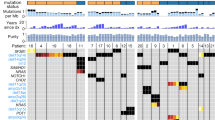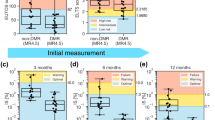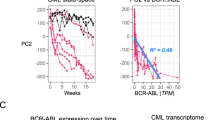Abstract
The clinical success of the ABL tyrosine kinase inhibitor imatinib in chronic myeloid leukaemia (CML) serves as a model for molecularly targeted therapy of cancer1,2,3,4, but at least two critical questions remain. Can imatinib eradicate leukaemic stem cells? What are the dynamics of relapse due to imatinib resistance, which is caused by mutations in the ABL kinase domain? The precise understanding of how imatinib exerts its therapeutic effect in CML and the ability to measure disease burden by quantitative polymerase chain reaction provide an opportunity to develop a mathematical approach. We find that a four-compartment model, based on the known biology of haematopoietic differentiation5, can explain the kinetics of the molecular response to imatinib in a 169-patient data set. Successful therapy leads to a biphasic exponential decline of leukaemic cells. The first slope of 0.05 per day represents the turnover rate of differentiated leukaemic cells, while the second slope of 0.008 per day represents the turnover rate of leukaemic progenitors. The model suggests that imatinib is a potent inhibitor of the production of differentiated leukaemic cells, but does not deplete leukaemic stem cells. We calculate the probability of developing imatinib resistance mutations and estimate the time until detection of resistance. Our model provides the first quantitative insights into the in vivo kinetics of a human cancer.
This is a preview of subscription content, access via your institution
Access options
Subscribe to this journal
Receive 51 print issues and online access
$199.00 per year
only $3.90 per issue
Buy this article
- Purchase on Springer Link
- Instant access to full article PDF
Prices may be subject to local taxes which are calculated during checkout




Similar content being viewed by others
References
Druker, B. J. et al. Effects of a selective inhibitor of the Abl tyrosine kinase on the growth of Bcr-Abl positive cells. Nature Med. 2, 561–566 (1996)
Sawyers, C. L. et al. Imatinib induces hematologic and cytogenetic responses in patients with chronic myelogenous leukemia in myeloid blast crisis: results of a phase II study. Blood 99, 3530–3539 (2002)
Holtz, M. S. et al. Imatinib mesylate (STI571) inhibits growth of primitive malignant progenitors in chronic myelogenous leukemia through reversal of abnormally increased proliferation. Blood 99, 3792–3800 (2002)
Hughes, T. P. et al. Frequency of major molecular responses to imatinib or interferon alfa plus cytarabine in newly diagnosed chronic myeloid leukemia. N. Engl. J. Med. 349, 1423–1432 (2003)
Spangrude, G. J., Heimfeld, S. & Weissman, I. L. Purification and characterization of mouse hematopoietic stem cells. Science 241, 58–62 (1988)
Bhatia, R. et al. Persistence of malignant hematopoietic progenitors in chronic myelogenous leukemia patients in complete cytogenetic remission following imatinib mesylate treatment. Blood 101, 4701–4707 (2003)
Chu, S. et al. Detection of BCR-ABL kinase mutations in CD34 + cells from chronic myelogenous leukemia patients in complete cytogenetic remission on imatinib mesylate treatment. Blood 105, 2093–2098 (2005)
Gorre, M. E. et al. Clinical resistance to STI-571 cancer therapy caused by BCR-ABL gene mutation or amplification. Science 293, 876–880 (2001)
Branford, S. et al. High frequency of point mutations clustered within the adenosine triphosphate-binding region of BCR/ABL in patients with chronic myeloid leukemia or Ph-positive acute lymphoblastic leukemia who develop imatinib (STI571) resistance. Blood 99, 3472–3475 (2002)
Branford, S. et al. Detection of BCR-ABL mutations in patients with CML treated with imatinib is virtually always accompanied by clinical resistance, and mutations in the ATP phosphate-binding loop (P-loop) are associated with a poor prognosis. Blood 102, 276–283 (2003)
Branford, S. et al. Real-time quantitative PCR analysis can be used as a primary screen to identify imatinib-treated patients with CML who have BCR-ABL kinase domain mutations. Blood 104, 2926–2932 (2004)
Hochhaus, A. et al. Molecular and chromosomal mechanisms of resistance to imatinib (STI571) therapy. Leukemia 16, 2190–2196 (2002)
Shah, N. P. et al. Multiple BCR-ABL kinase domain mutations confer polyclonal resistance to the tyrosine kinase inhibitor imatinib (STI571) in chronic phase and blast crisis chronic myeloid leukemia. Cancer Cell 2, 117–125 (2002)
Roche-Lestienne, C. et al. Several types of mutations of the Abl gene can be found in chronic myeloid leukemia patients resistant to STI571, and they can pre-exist to the onset of treatment. Blood 100, 1014–1018 (2002)
Roche-Lestienne, C., Lai, J. L., Darre, S., Facon, T. & Preudhomme, C. A mutation conferring resistance to imatinib at the time of diagnosis of chronic myelogenous leukemia. N. Engl. J. Med. 348, 2265–2266 (2003)
Branford, S., Hughes, T. P. & Rudzki, Z. Monitoring chronic myeloid leukaemia therapy by real-time quantitative PCR in blood is a reliable alternative to bone marrow cytogenetics. Br. J. Haematol. 107, 587–599 (1999)
Cortes, J., O'Brien, S. & Kantarjian, H. Discontinuation of imatinib therapy after achieving a molecular response. Blood 104, 2204–2205 (2004)
Higashi, T. et al. Imatinib mesylate-sensitive blast crisis immediately after discontinuation of imatinib mesylate therapy in chronic myelogenous leukemia: report of two cases. Am. J. Hematol. 76, 275–278 (2004)
Graham, S. M. et al. Primitive, quiescent, Philadelphia-positive stem cells from patients with chronic myeloid leukemia are insensitive to STI571 in vitro. Blood 99, 319–325 (2002)
Chaudhary, P. M. & Roninson, I. B. Expression and activity of P-glycoprotein, a multidrug efflux pump, in human hematopoietic stem cells. Cell 66, 85–94 (1991)
Mahon, F. X. et al. MDR1 gene overexpression confers resistance to imatinib mesylate in leukemia cell line models. Blood 101, 2368–2373 (2003)
Branford, S. et al. The incidence of BCR-ABL kinase mutations in chronic myeloid leukemia patients is as high in the second year of imatinib therapy as the first but survival after mutation detection is significantly longer for patients with mutations detected in the second year of therapy. Blood 102, 414 (2003)
Kunkel, T. A. & Bebenek, K. DNA replication fidelity. Annu. Rev. Biochem. 69, 497–529 (2000)
Holyoake, T. L., Jiang, X., Drummond, M. W., Eaves, A. C. & Eaves, C. J. Elucidating critical mechanisms of deregulated stem cell turnover in the chronic phase of chronic myeloid leukemia. Leukemia 16, 549–558 (2002)
Holyoake, T., Jiang, X., Eaves, C. & Eaves, A. Isolation of a highly quiescent subpopulation of primitive leukemic cells in chronic myeloid leukemia. Blood 94, 2056–2064 (1999)
Mahon, F. X. et al. MDR1 gene overexpression confers resistance to imatinib mesylate in leukemia cell line models. Blood 101, 2368–2373 (2003)
Chaudhary, P. M. & Roninson, I. B. Expression and activity of P-glycoprotein, a multidrug efflux pump, in human hematopoietic stem cells. Cell 66, 85 (1991)
Bedi, A. et al. BCR-ABL gene rearrangement and expression of primitive hematopoietic progenitors in chronic myeloid leukemia. Blood 81, 2898–28902 (1993)
Shah, N. P. et al. Overriding imatinib resistance with a novel ABL kinase inhibitor. Science 305, 399–401 (2004)
Acknowledgements
We thank R. Lawrence and C. Field for technical assistance with the BCR-ABL quantitative and mutation analysis. N.P.S. and C.L.S. acknowledge support from the Leukemia and Lymphoma Society. The Program for Evolutionary Dynamics at Harvard University is supported by J. Epstein. N.P.S. is the recipient of a Mentored Clinical Pharmacology Research Scholars Program Award. Author Contributions F.M. is a Junior Fellow of the Harvard Society of Fellows. C.L.S. is an Investigator of the Howard Hughes Medical Institute, and a Doris Duke Distinguished Clinical Scientist.
Author information
Authors and Affiliations
Corresponding author
Ethics declarations
Competing interests
Reprints and permissions information is available at npg.nature.com/reprintsandpermissions. The authors declare no competing financial interests.
Supplementary information
Supplementary Notes
The basic model, the probability of resistance mutations, quantitative real-time polymerase-chain-reaction measurements, additional references and Supplementary Figure Legend. (PDF 53 kb)
Supplementary Figures and Supplementary Tables
Supplementary Figure S1 shows the molecular response to imatinib. Also contains Supplementary Table S1, Supplementary Table S2 and Supplementary Table S3. (PDF 155 kb)
Rights and permissions
About this article
Cite this article
Michor, F., Hughes, T., Iwasa, Y. et al. Dynamics of chronic myeloid leukaemia. Nature 435, 1267–1270 (2005). https://doi.org/10.1038/nature03669
Received:
Accepted:
Issue Date:
DOI: https://doi.org/10.1038/nature03669
This article is cited by
-
Dynamics of a diffusive model for cancer stem cells with time delay in microRNA-differentiated cancer cell interactions and radiotherapy effects
Scientific Reports (2024)
-
Overcoming BCR::ABL1 dependent and independent survival mechanisms in chronic myeloid leukaemia using a multi-kinase targeting approach
Cell Communication and Signaling (2023)
-
The structure of the hematopoietic system can explain chronic myeloid leukemia progression
Scientific Reports (2023)
-
A comprehensive regulatory and industry review of modeling and simulation practices in oncology clinical drug development
Journal of Pharmacokinetics and Pharmacodynamics (2023)
-
Progression, detection and remission: evolution of chronic myeloid leukemia using a three-stage probabilistic model
Journal of Applied Mathematics and Computing (2023)
Comments
By submitting a comment you agree to abide by our Terms and Community Guidelines. If you find something abusive or that does not comply with our terms or guidelines please flag it as inappropriate.



